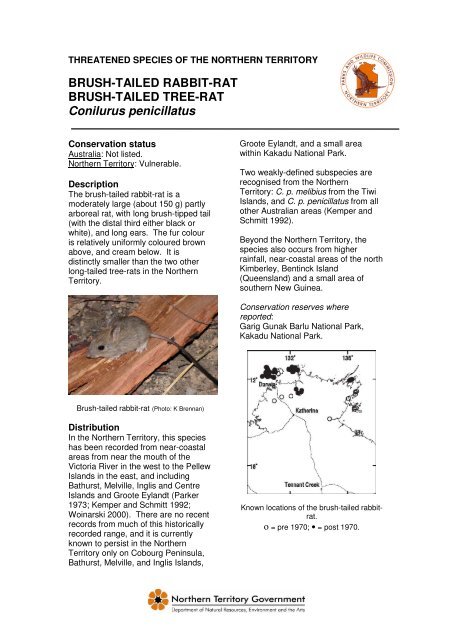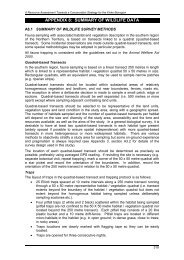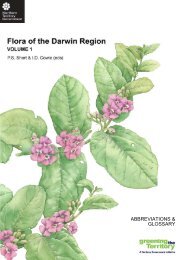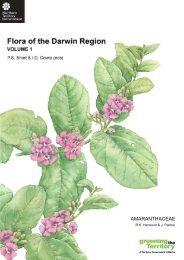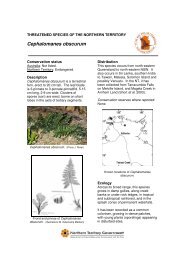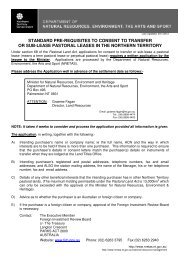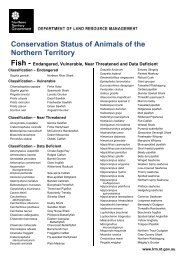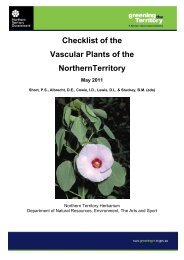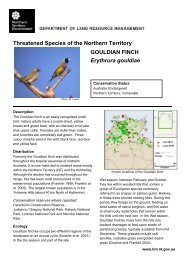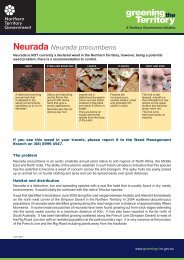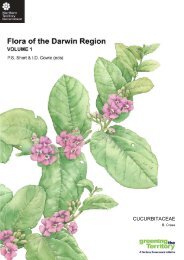BRUSH-TAILED RABBIT-RAT BRUSH-TAILED TREE-RAT ...
BRUSH-TAILED RABBIT-RAT BRUSH-TAILED TREE-RAT ...
BRUSH-TAILED RABBIT-RAT BRUSH-TAILED TREE-RAT ...
Create successful ePaper yourself
Turn your PDF publications into a flip-book with our unique Google optimized e-Paper software.
THREATENED SPECIES OF THE NORTHERN TERRITORY<br />
<strong>BRUSH</strong>-<strong>TAILED</strong> <strong>RABBIT</strong>-<strong>RAT</strong><br />
<strong>BRUSH</strong>-<strong>TAILED</strong> <strong>TREE</strong>-<strong>RAT</strong><br />
Conilurus penicillatus<br />
Conservation status<br />
Australia: Not listed.<br />
Northern Territory: Vulnerable.<br />
Description<br />
The brush-tailed rabbit-rat is a<br />
moderately large (about 150 g) partly<br />
arboreal rat, with long brush-tipped tail<br />
(with the distal third either black or<br />
white), and long ears. The fur colour<br />
is relatively uniformly coloured brown<br />
above, and cream below. It is<br />
distinctly smaller than the two other<br />
long-tailed tree-rats in the Northern<br />
Territory.<br />
Brush-tailed rabbit-rat (Photo: K Brennan)<br />
Distribution<br />
In the Northern Territory, this species<br />
has been recorded from near-coastal<br />
areas from near the mouth of the<br />
Victoria River in the west to the Pellew<br />
Islands in the east, and including<br />
Bathurst, Melville, Inglis and Centre<br />
Islands and Groote Eylandt (Parker<br />
1973; Kemper and Schmitt 1992;<br />
Woinarski 2000). There are no recent<br />
records from much of this historically<br />
recorded range, and it is currently<br />
known to persist in the Northern<br />
Territory only on Cobourg Peninsula,<br />
Bathurst, Melville, and Inglis Islands,<br />
Groote Eylandt, and a small area<br />
within Kakadu National Park.<br />
Two weakly-defined subspecies are<br />
recognised from the Northern<br />
Territory: C. p. melibius from the Tiwi<br />
Islands, and C. p. penicillatus from all<br />
other Australian areas (Kemper and<br />
Schmitt 1992).<br />
Beyond the Northern Territory, the<br />
species also occurs from higher<br />
rainfall, near-coastal areas of the north<br />
Kimberley, Bentinck Island<br />
(Queensland) and a small area of<br />
southern New Guinea.<br />
Conservation reserves where<br />
reported:<br />
Garig Gunak Barlu National Park,<br />
Kakadu National Park.<br />
Known locations of the brush-tailed rabbitrat.<br />
ο = pre 1970; • = post 1970.
Ecology<br />
The preferred habitat of the brushtailed<br />
tree-rat is eucalypt tall open<br />
forest (Firth et al. 2006a) . However, at<br />
least on Cobourg Peninsula, it also<br />
occurs on coastal grasslands (with<br />
scattered large Casuarina equisetifolia<br />
trees, beaches, and stunted eucalypt<br />
woodlands on stony slopes (Frith and<br />
Calaby 1974; PWCNT 2001).<br />
It shelters in tree hollows, hollow logs<br />
and, less frequently, in the crowns of<br />
pandanus or sand-palms (Firth et al.<br />
2006b). Most foraging is on the<br />
ground, but it is also partly arboreal.<br />
The diet comprises mainly seeds<br />
(especially of grasses), with some<br />
fruits, invertebrates and leaves and<br />
grass (Firth et al. 2005).<br />
Conservation assessment<br />
Conservation assessment is<br />
hampered by lack of knowledge<br />
concerning the timing, extent and<br />
currency of geographic decline, and<br />
the lack of a comprehensive recent<br />
assessment of their status on Groote<br />
Eylandt and Centre Island. Relatively<br />
brief recent (2003-2005) surveys failed<br />
to re-locate the species on Centre<br />
Island (Taylor et al. 2004; S. Ward<br />
pers. comm.), but reported one<br />
individual on Groote Eylandt (D. Milne<br />
pers. comm.). Its range and<br />
population size in the Northern<br />
Territory has probably declined by well<br />
over 50% since European settlement,<br />
but this decline cannot be dated with<br />
any assurance. Certainly, its current<br />
status no longer matches that reported<br />
more than 100 years ago: “in Arnhem<br />
Land is everywhere common in the<br />
vicinity of water” (Dahl 1897),<br />
“numerous all over Arnhem Land, and<br />
in great numbers on the rivers of the<br />
lowlands” (Collett 1897). There is<br />
some suggestion of a decline within<br />
the last 20 years at Kakadu National<br />
Park, but this is based on very few<br />
records (Woinarski et al. 2001).<br />
Current research will provide some<br />
assessment of the population size (or<br />
Threatened Species Information Sheet<br />
at least an index of abundance, whose<br />
assessment can be consistently<br />
repeated) on Bathurst and Melville<br />
Islands, Cobourg Peninsula and<br />
Kakadu. A recent study (PWCNT<br />
2001) found very high population<br />
density (>6 individuals/ha) in at least<br />
two locations on Cobourg Peninsula.<br />
Its status best fits Vulnerable (under<br />
the criteria B1ab(i,ii,iii,iv,v) based on:<br />
• extent of occurrence estimated to<br />
be
may have changed the availability of<br />
preferred or vital food resources (e.g.<br />
seeds or stems from particular grass<br />
species), and more frequent hot fires<br />
may have reduced the availability of<br />
hollow logs, tree hollows and the tall<br />
fruit-bearing understorey shrubs, and<br />
unfavourably changed the composition<br />
of grass species (Woinarski et al.<br />
2004; Firth et al. 2005, 2006b).<br />
The population on the Tiwi Islands has<br />
been substantially reduced by recent<br />
clearing for forestry plantation of about<br />
30,000 ha of its prime habitat (Firth et<br />
al. 2006a); and there are proposals to<br />
extend this forestry enterprise up to<br />
100,000 ha.<br />
Conservation objectives and<br />
management<br />
There is no existing recovery plan or<br />
management program for this species.<br />
In the interim, management priorities<br />
are to:<br />
(i) maintain a monitoring program in at<br />
least two sites, which can also<br />
measure responses to management<br />
actions. The baseline for this<br />
monitoring has now been established,<br />
with recent studies on Cobourg<br />
Peninsula, the Tiwi Islands and in<br />
Kakadu National Park.<br />
(ii) work with Aboriginal landowners to<br />
maintain effective quarantine actions<br />
for island populations, most<br />
particularly relating to maintaining at<br />
least some of these islands cat-free.<br />
(iii) develop effective captive<br />
population breeding programs, and<br />
evaluate the possibility of establishing<br />
translocated populations (either to<br />
currently uninhabited islands or to<br />
appropriately managed conservation<br />
reserves). Such a program is currently<br />
being undertaken through the Territory<br />
Wildlife Park.<br />
(iv) ensure that habitat clearance for<br />
plantation forestry on the Tiwi Islands<br />
does not compromise population<br />
viability.<br />
Threatened Species Information Sheet<br />
Compiled by<br />
John Woinarski<br />
[January 2007]<br />
References<br />
Collett, R. (1897). On a collection of<br />
mammals from North and North-west<br />
Australia. Proceedings of the<br />
Zoological Society of London 1897,<br />
317-336.<br />
Dahl, K. (1897). Biological notes on<br />
north-Australian mammalia.<br />
Zoologist, Series 4, 1, 189-216.<br />
Firth, R.S.C., Jefferys, E., Woinarski,<br />
J.C.Z., and Noske, R.A. (2005). The<br />
diet of the brush-tailed rabbit-rat<br />
Conilurus penicillatus from the<br />
monsoonal tropics of the Northern<br />
Territory, Australia. Wildlife Research<br />
32, 517-524.<br />
Firth, R.S.C., Woinarski, J.C.Z., Brennan,<br />
K.G., and Hempel, C. (2006a).<br />
Environmental relationships of the<br />
brush-tailed rabbit-rat Conilurus<br />
penicillatus and other small mammals<br />
on the Tiwi Islands, northern<br />
Australia. Journal of Biogeography<br />
33, 1820-1837.<br />
Firth, R.S.C., Woinarski, J.C.Z., and<br />
Noske, R.A. (2006b). Home range<br />
and den characteristics of the brushtailed<br />
rabbit-rat Conilurus penicillatus<br />
in the monsoonal tropics of the<br />
Northern Territory, Australia. Wildlife<br />
Research 33, 397-408.<br />
Frith, H.J., and Calaby, J.H. (1974).<br />
Fauna survey of the Port Essington<br />
district, Cobourg Peninsula, Northern<br />
Territory of Australia. Technical<br />
Paper no. 28. (CSIRO Wildlife<br />
Research, Canberra.)<br />
Kemper, C.M., and Schmitt, L.H. (1992).<br />
Morphological variation between<br />
populations of the brush-tailed treerat<br />
(Conilurus penicillatus) in northern<br />
Australia and New Guinea.<br />
Australian Journal of Zoology 40,<br />
437-452.<br />
Parker, S.A. (1973). An annotated<br />
checklist of the native land mammals<br />
of the Northern Territory. Records of<br />
the South Australian Museum 16, 1-<br />
57.<br />
PWCNT (2001). Studies of the brushtailed<br />
tree-rat Conilurus penicillatus in<br />
Gurig National Park. (PWCNT,<br />
Darwin.)<br />
Taylor, R., Woinarski, J., Charlie, A.,<br />
Dixon, R., Pracy, D., and Rhind, S.
(2004). Report on mammal survey of<br />
the Pellew Islands 2003.<br />
(Lianthawirriyarra Sea Ranger Unit,<br />
Department of Infrastructure,<br />
Planning and Environment, and<br />
Tropical Savannas CRC, Darwin)<br />
Woinarski, J.C.Z. (2000). The<br />
conservation status of rodents in the<br />
Top End of the Northern Territory.<br />
Wildlife Research 27, 421-435.<br />
Woinarski, J.C.Z., Milne, D.J., and<br />
Wanganeen, G. (2001). Changes in<br />
mammal populations in relatively<br />
intact landscapes of Kakadu National<br />
Park, Northern Territory, Australia.<br />
Austral Ecology 26, 360-370.<br />
Woinarski, J.C.Z., Armstrong, M., Price,<br />
O., McCartney, J., Griffiths, T., and<br />
Fisher, A. (2004). The terrestrial<br />
vertebrate fauna of Litchfield National<br />
Park, Northern Territory: monitoring<br />
over a 6-year period, and response to<br />
fire history. Wildlife Research 31, 1-<br />
10.<br />
Threatened Species Information Sheet


